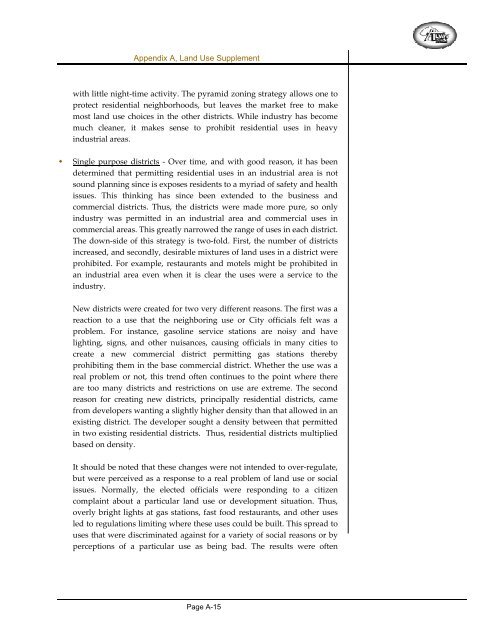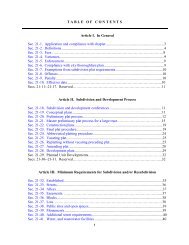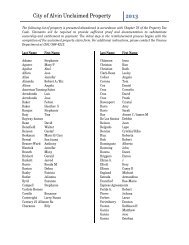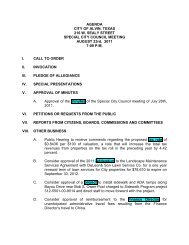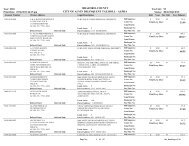Comprehensive Master Plan - City of Alvin
Comprehensive Master Plan - City of Alvin
Comprehensive Master Plan - City of Alvin
- No tags were found...
Create successful ePaper yourself
Turn your PDF publications into a flip-book with our unique Google optimized e-Paper software.
Appendix A, Land Use Supplementwith little night‐time activity. The pyramid zoning strategy allows one toprotect residential neighborhoods, but leaves the market free to makemost land use choices in the other districts. While industry has becomemuch cleaner, it makes sense to prohibit residential uses in heavyindustrial areas.• Single purpose districts ‐ Over time, and with good reason, it has beendetermined that permitting residential uses in an industrial area is notsound planning since is exposes residents to a myriad <strong>of</strong> safety and healthissues. This thinking has since been extended to the business andcommercial districts. Thus, the districts were made more pure, so onlyindustry was permitted in an industrial area and commercial uses incommercial areas. This greatly narrowed the range <strong>of</strong> uses in each district.The down‐side <strong>of</strong> this strategy is two‐fold. First, the number <strong>of</strong> districtsincreased, and secondly, desirable mixtures <strong>of</strong> land uses in a district wereprohibited. For example, restaurants and motels might be prohibited inan industrial area even when it is clear the uses were a service to theindustry.New districts were created for two very different reasons. The first was areaction to a use that the neighboring use or <strong>City</strong> <strong>of</strong>ficials felt was aproblem. For instance, gasoline service stations are noisy and havelighting, signs, and other nuisances, causing <strong>of</strong>ficials in many cities tocreate a new commercial district permitting gas stations therebyprohibiting them in the base commercial district. Whether the use was areal problem or not, this trend <strong>of</strong>ten continues to the point where thereare too many districts and restrictions on use are extreme. The secondreason for creating new districts, principally residential districts, camefrom developers wanting a slightly higher density than that allowed in anexisting district. The developer sought a density between that permittedin two existing residential districts. Thus, residential districts multipliedbased on density.It should be noted that these changes were not intended to over‐regulate,but were perceived as a response to a real problem <strong>of</strong> land use or socialissues. Normally, the elected <strong>of</strong>ficials were responding to a citizencomplaint about a particular land use or development situation. Thus,overly bright lights at gas stations, fast food restaurants, and other usesled to regulations limiting where these uses could be built. This spread touses that were discriminated against for a variety <strong>of</strong> social reasons or byperceptions <strong>of</strong> a particular use as being bad. The results were <strong>of</strong>tenPage A-15


